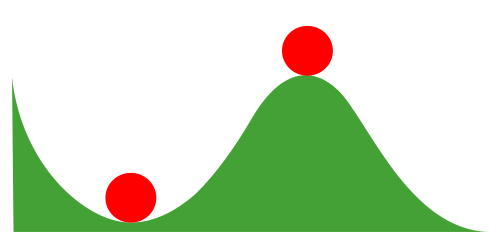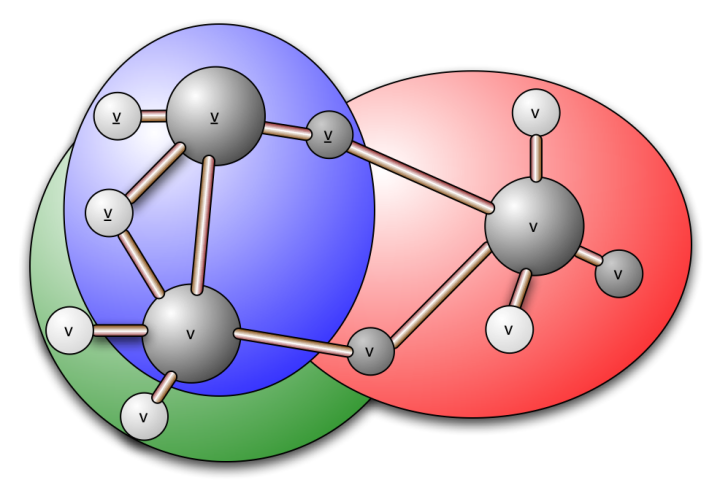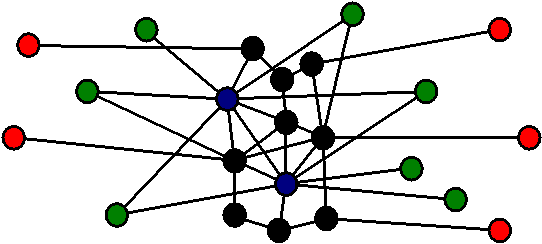The inevitable instability of systems
Sometimes we tend to believe in the stability of systems. Systems are sometimes designed, think about road- or rail systems, or sometimes they are discovered, like stellar systems or the behavior of ant colonies. We design for the best, making it as robust as possible. Or when we discover them, we are amazed about the complexity of it. In most cases, we just don’t understand them with the universe as we know it as the best example.
Why is it that we tend to think that systems need to be stable? Cant’t we just accept that everything where energy (or another flow) is involved is by definition unstable? Sometimes a system appears to be stable, but in time it will become unstable and ultimately it will collapse. Road systems will collapse because too many cars drive on them, because there is not enough construction, or because they become superfluous. Stellar systems are unstable because they will collapse with others or they faint away (no more energy), and ant colonies will disappear.
My understanding is that every system that is created at some point will disappear at another point, and that energy is the fuel that is needed to create and maintain it, but that energy will also destroy it. Without energy a system is dead (maybe stable?), therefore it is inevitable that a system is unstable by definition. So the only stable system might be a dead system. Characteristics of a system are structure, behavior and interconnectivity, all three influence each other resulting in change in those characteristics. While a system exists, those three characteristics influence and change each other. At one point a minor change can start the disruption of the system.
By accepting that systems are per definition unstable, can we design better systems? Let go of control, and accept that the end of one system can mean the beginning of another. Or by letting two systems collapse in a controlled manner, this can mean the start of a new (and perhaps better) one. If we bring this philosophy into organizations (or economies), what can we learn from this? Can we develop new design principles that respect the temporal nature of systems? What is we always include a scenario of the end of the system while we design it? I think this would be a lot better. Think about the current banking issues. Banks collapse, and we try to ‘save’ them. It is basically a quick fix without thinking things through. We think this system is needed, but we haven’t thought through alternatives, and certainly did not think about what to do when this system might fail at some point, certainly not when this system was introduced.
The banking system is not needed for humanity. At some point it seemed a good system for us, and it still might be for some time despite the huge financial injections. But this system is not there forever, and we have seen it’s weaknesses. One of the best example of a temporary system is the democratic system. By definition we accept that they are unstable, and we’ve built in rules to make sure it will collapse quickly. It is not the most efficient system, but it is a system that renews itself on a regular basis. While the democratic system itself can collapse as well, we do not try to make it efficient and stable. That would bring us to dictatorship, which is efficient but has it’s disadvantages.
So, maybe more questions than answers or solutions, and maybe questions that were asked many times before, but some questions need to be asked again and again. Last but not least: systems are interconnected not only with itself, but also with other systems. Let’s not forget that one while designing systems. Instability of one system might be needed (or even crucial, think about day and night, rain and drought) for the stability of another.
The importance of philosophy
Inspiration to write about something can sometimes be hard to find. That’s what’s happened to me this year. For whatever reason, writing on this blog didn’t happen at all. Fortunately inspiration is best found when you’re not looking for it, thanks to Chris Jones while mentioning his latest blogpost. Chris wrote about science and philosophy. He argues for a common ground called complexity. Interesting post, I would recommend anyone to read it fully. It was this post that made me think about the importance of philosophy in many fields. My reply on Chris’ post was the following:
Science is timely, philosophy is timeless. What’s true now in science can be false tomorrow. That’s a fact. In philosophy there is no true or false. What’s true in situation A, can be false in situation B. Differences in culture, beliefs, age, etc. defines what’s true or not in philosophy, and in general this diversity in thinking is considered a richness for many of us. It enables us to change perspective and rethink theories or ‘facts’ that can lead to other conclusions. In many cases it can even change the current state of science (think radical, for example the concepts of time or gravity). So science benefits from philosophy, like many fields of interest benefits from philosophy. Without philosophy, science would not progress. So therefore I would argue that science, like many other fields is a dependent of philosophy.
Because Chris put science and philosophy next to each other in a picture, like they represent two separate modes of thinking, that made me think. When you place philosophy on the right (like in the picture), then the left part is not only science. I rather would place philosophy in the center as it represents our ability to think (both left and right in the brain), and science as one of the many satellites around philosophy. Science is a product of our thinking, philosophy is the process of thinking. But what about art?
I use the term process because in philosophy, there is no common ground, no result. Only the topics are shared amongst them. Many philosophers disagree on the big questions in life. Religion, existence, free will, reason, ethics; these are the big topics that make philosophers think. The ambiguity in philosophy between many philosophers’ thinking is key to make progress here. The seeming inefficiency by disagreement is actually very effective. It’s the only way we can think from different perspectives, making it possible to advance in science, technology, political issues, human rights and so on. In that sense, philosophy is at the center of everything we can imagine. There would be no science without philosophy, neither would there be religion or ethics.
Philosophy is the process of thinking. Wisdom and knowledge (to name a few) the result. In that sense, you cannot argue that philosophy is in our right brain, or science on the right. I would compare it with the duality introduced by Wenger: “The negotiation of meaning involves the interaction of two processes, participation and reification, which form a duality“, where reification is the result of the process of participation, making the abstract more concrete.
Sharing and buying, what’s our currency?
Discussions about new currencies in this age of sharing are not new. Many have done research about other means of value compared to money as we know it. During the rise of the internet, we exchange value more easily without the need of money. And then there is this other characteristic what really differs from money: abundance. Nowadays there is an abundance of knowledge, an abundance of people who know how to find people for specific needs, or willing to share experiences, ideas or knowledge about numerous subjects like travel, product reviews, music or even business experiences. The latter is rather difficult for many people. Sharing is all good they would say, but about personal stuff rather than professional. Why share all your knowledge about foreign markets, while you’ve spent all your working life to build it up?
That question is an interesting one to answer. Why would you do that? And if you would, with whom? It can represent your competitive advantage, an advantage that you would like to keep intact. As with many seeming threats, it’s better to seek for ways to use the ‘threat’ as new chances, because if you’re not the one who’s willing to share, others will. So as a knowledge leader, someone who really is good in some specific areas, it can be a good strategy to position yourself that way. There are enough examples of ‘knowledge leaders’ that make use of channels to share their knowledge where it can be copied easily. Books are not the only way, the internet provides faster and wider spreading of the valuable information. Protecting the knowledge is not needed when you want it to be shared. It’s your new marketing channel. 37signals is my favorite example here, they try share their knowledge and strategy as much as possible, and with result.
Another interesting characteristic of sharing is its value. Knowledge (is every form, such as experiences or market knowledge) has value. Value for the sender and it’s recipients. But real value is created when people come back to the sender with unexpected responses which can lead to new insights, new ideas, or combinatorial innovation. See what happens in forums like some on LinkedIn, for example. People find each other, discuss topics, and collaborate which is good for all participants and spectators.
Sharing knowledge is not the same as giving up competitive advantages. In an age where sharing is easy, you’d better use it in your advantage. Of course, first things first, you still need enough money to make a living, but on top of that we exchange more and more without the intervention of real money. So you can ask yourself what our currency really is. It seems to shift more and more away from money as a medium of exchange, to an exchange of knowledge, experiences, which builds relationships and trust, and spurs innovation. 1+1=3. Above post is the result of sharing thoughts with a colleague about being open or closed about you business experiences, and at the same time an argument for trying to share as much as possible to encourage new ways of value creation.
Some interesting reads on this subject:
The complexity of complexity
A recent discussion on Twitter on complexity triggered me to write this post. Clearly, it is a subject that is being interpreted in many (3?) ways. Complex, chaos, simple, complicated, anarchy, all terms that are being compared in order to try to understand what they (should) mean. Some argue that you can use axes and create a spectrum, where all these phenomena can be plotted upon. Others disagree with the language used, or that these levels exist for complexity. And then there are other misunderstandings or misinterpretations. For example, complexity and Complex Adaptive Systems (CAS) are not exactly the same. We’re talking about the complexity of complexity.
Good for us humans, our thinking and behavior is quite complex as well. We are able to understand complex matter, albeit when looking back. We are used to think in linear ways, especially when we try to predict things to happen. In retrospective, we are capable of understanding things (events, behavior, etc.) that can be called complex. The most important attribute of complexity is non-linearity. Quite interesting finding, when looking back to understand phenomena it seems linear, looking ahead to the future, expect non-linear behavior. Is that complexity? No, it’s just uncertainty. Quite different things. And when looking back, uncertainty is gone, one outcome emerged in favor of many, at the time possible, outcomes.
Now I’ve almost lost myself in the above paragraph. Of course, complexity is related to uncertainty. However, the range certainty-uncertainty does not classify complexity, nor does predictability. In my view, complexity can not be classified, influenced or whatever. Complexity is an attribute of the behavior of a whole, where many actors are somehow involved and influence each other.
To me, complexity is not about systems. It’s about social phenomena. We can talk about the ‘problems’ of complexity and complex behavior, rather I’d talk about the opportunities. Dave Snowden understands this very well. Like I’ve said before regarding emergence, I’d like to say the same about complexity. It’s time to accept and embrace complexity, and to develop methods to get the most out of complex social phenomena or behavior. To be able to develop these methods it is important to understand complexity, however, I think we should not try to understand complexity fully. Our understanding will become better sooner or later, but we have to deal with it now. That’s inevitable.
Everything is emergent
In a world that changes increasingly faster and faster, the perceived complexity increases with it. It becomes harder to predict the status quo even on the short-term, perhaps even that of tomorrow. The attempts to make predictions become useless. An obsolete approach.
We need to stop acting like we have control over what will happen in the future. We just don’t know. Often we are not even close. What’s the point of making predictions of the future anyway, and then trying to control what happens?
Organizations are the best example of future predictors. They keep trying to figure out the most likely scenario’s to occur based on what happened in the past. Organizations have difficulties in accepting the fact that these predictions are not only a waste of time, it’s even worse than that. They even try to understand what happened in the past based on the present situation. What happened in the past was just one of the possible outcomes. There are no parallel pasts that occurred at the same time and that have led to where we are now. Rationalizing what happened then, is like denying what could have occurred. Sometimes it helps to understand phenomena, but using that for future predictions means that the same mistakes are being made over and over again.
Again, we have to stop predicting, and start nurturing the current situation in a way that good outcomes will flourish, independent of what that outcome can be. It’s not the outcome that matters most, it’s the road to it. The road to it (where ever it will lead) is an emergent path. So many influences are on the lurk, so many that no one knows how many and what they are, that they should be dealt with along the way. They both can be positive or negative, both will have influence on the emergence.
Dealing with matter like I described above is so different then how we are used to, and not only different, but scary as well. To accept and be comfortable with uncertain paths is not suitable for most organizations nowadays. And it won’t be for the years to come probably. However, we see more and more organizations that operate in a networked environment, where many stakeholders play a role. In these situations, long-term strategies are being replaced by emergent strategies, where control does not have a place.
Coming back to the title of the post, maybe it is somewhat exaggerated at the moment, maybe it is more realistic to speak of a change from long-term goals to short-term goals. Dealing with short-term goals combined with iterative processes is a good first step towards completely letting go of control and accepting that everything is emergent. We are humans with brains that can think ahead in time, let’s not forget that important aspect of us.
Empowerment, a management fad?
A term that is used in many circumstances, is empowerment. It is used on so many occasions (both verbally and in written text), that I feel that it is misused more often than that it is used correctly. Or is it just a management fad, like BPR or TQM?
Empowerment refers to increasing the spiritual, political, social or economic strength of individuals and communities. It often involves the empowered developing confidence in their own capacities. […] Empowerment is the process that allows one to gain the knowledge, skill-sets and attitude needed to cope with the changing world and the circumstances in which one lives.
Ok, that’s what Wikipedia reads. The post of Mike Griffiths recently triggered (or empowered?) me to rethink empowerment. I can recall some papers I’ve read some years ago at the university about the subject. I also remember the debate it triggered there, because it can be interpreted in so many ways. Empowerment can refer to both individuals and communities. It refers to empowering a person or the collective. How does this work? Some questions come to mind here:
- Is empowerment something that benefits only people without any power?
- Who is powerful enough to empower others?
- Who knows what is needed to empower someone? (perhaps only the unempowered)
- Who or what benefits from empowerment?
- Why is the term interpreted in so many ways?
- Is empowerment of an individual or group a prerequisite for self-organization?
 Without answering these questions immediately, I’d like to look at some real world examples where I think that empowerment is taking place. These places have some things in common. These places generally have a leader that leads the company quite different that the common leadership practices. They are not alone and unattainable at the top of the pyramid, they make sure that employees are involved not only in their own tasks and responsibilities, they know what their clients want and make sure that their employees know as well. These and some other characteristics are practices by only a few leaders, leaders that dare to make extraordinary decisions, that give control to their employees. Companies that have some similarities with these characteristics are Zappos and Semco, for example. These are companies that make quite ordinary products, have great results, but run their companies not like their competitors do. I’d like to call these companies examples of the real empowering companies. You just feel that you would like to work for them. That makes a company a great company, if you ask me.
Without answering these questions immediately, I’d like to look at some real world examples where I think that empowerment is taking place. These places have some things in common. These places generally have a leader that leads the company quite different that the common leadership practices. They are not alone and unattainable at the top of the pyramid, they make sure that employees are involved not only in their own tasks and responsibilities, they know what their clients want and make sure that their employees know as well. These and some other characteristics are practices by only a few leaders, leaders that dare to make extraordinary decisions, that give control to their employees. Companies that have some similarities with these characteristics are Zappos and Semco, for example. These are companies that make quite ordinary products, have great results, but run their companies not like their competitors do. I’d like to call these companies examples of the real empowering companies. You just feel that you would like to work for them. That makes a company a great company, if you ask me.
To come back to some of the questions I posed earlier in this post, for example the question ‘Why is the term interpreted in so many ways?‘, I can say it depends heavily on who used the term. It can be the manager that tries to make others only work harder instead of really making them really more responsible for what they do, or it can be the employee that feels like not having enough resources or information he or she needs, or to feel more involved. If empowerment is a management fad, is hard to answer. I think it can easily be or become a management fad, but some core-principles that can be attributed to empowerment are really valuable and here to stay. These are universal, humane and part of the science of empowerment.
Another question I asked in this post is ‘Is empowerment of an individual or group a prerequisite for self-organization?‘. Perhaps it is. Empowered employees are able to manage themselves, both individually or in a collective. Maybe it is self-management, however, I prefer to make use of self-organization, for obvious reasons. In the problem statement I stated some time ago, I made an assumption by stating ‘how to […] empower employees for self-organization?‘. It seems this assumption still stands for me. To be continued…









leave a comment